100 Rock Climbing Terms to Know (Lingo Guide 2024)
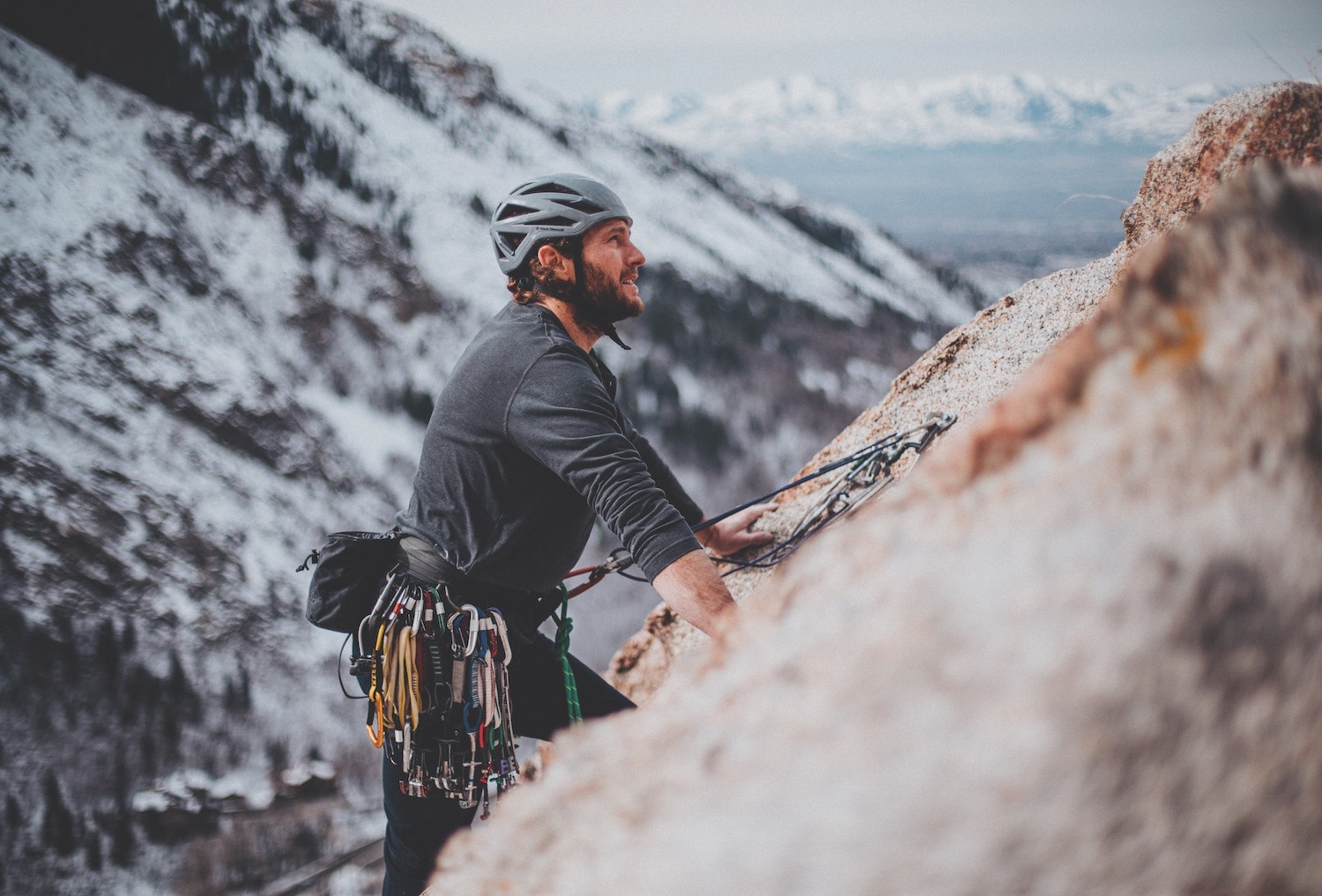
Climbing is a very technical activity with new terms at every corner. This can especially be intimidating for beginners who recently started climbing, but advanced climbers are also bound to learn something new as they progress.
To help you keep up or show off to your friends, we’ve selected 100 important rock climbing terms that every climber should know with very simple definitions. Any doubts? Please ask in the comments section.
1. Abseiling
A term used interchangeably with rappelling, mainly in the UK and European countries.
2. Aid climbing
A type of climbing where climbers use gear (e.g. ropes, bolts, and pitons) to ascend rather than the rock’s natural features. The opposite of aid climbing is free climbing where climbers only use gear for protection.
3. Anchor
Any attachment point to secure a climbing rope to the surface (e.g. rock or ice). Anchors can be at the end of a climb (e.g. top-rope anchor), mid-climb for protection, or at a belay station (i.e. belay anchor) to secure the belayer. Climbers have many options to build anchors like slings, bolts, quickdraws, and carabiners.
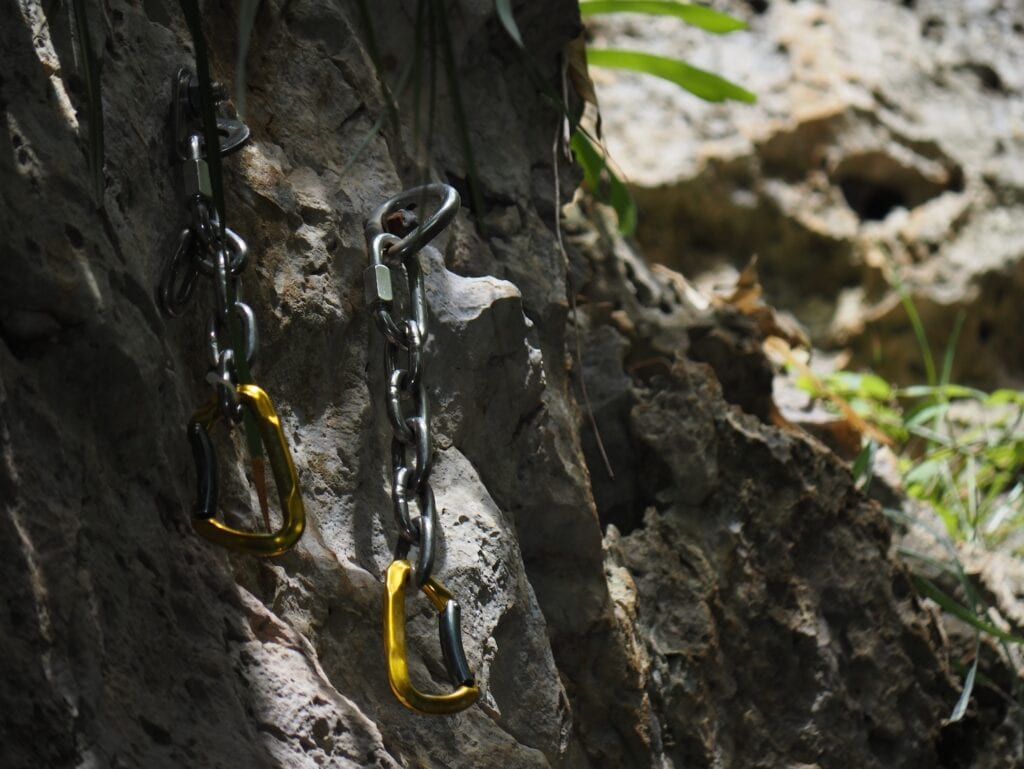
4. Approach
The path leading to the starting point of a climb. Depending on the popularity and nature of the climb, the approach can be a clear route or an uncharted trail. Approaching a climb can take a few minutes or days, depending on the location of the climb and the environment.
5. Approach shoes
Hiking shoes specialized for approaching climbs. Approach shoes are generally low-cut, lightweight, and with a climbing zone (hard rubber part) under the big toe for climbing easy technical routes.
6. ATC
A famous tube-style belay device created by Black Diamond. Check out this article for more information.

7. Auto-belay
Short for automatic belay. A type of climbing, mostly in gyms, where the climber clips into an auto-belay device secured to the top of the climbing wall. The auto-belay device automatically takes slack as the climber ascends and lowers them to the ground if they fall or jump, thus removing the need for a human belayer.
8. Barn door
A barn door (or barn dooring) occurs when the climber swings away with the hand and foot on the same side of the body connected to the wall. The motion is reminiscent of a barn door opening, hence the name. Barn doors are common on slab and vertical terrain requiring subtle body movement, and dynamic bouldering problems.
9. Belay
A belay is a friction-based system to secure a climber in case of a call. It consists of a rope attached to the climber, connected to the belayer through a belay device, and secured to the wall through anchors.
The act of belaying refers to a belayer using the belay system to secure the climber.
There are a few types of belaying depending on the type of climbing you practice.
10. Belayer
The person who manages the climber’s rope to secure them in the event of a fall and give them slack as they ascend. On a single-pitch route, the belayer also lowers the climber safely to the ground after they have finished climbing.
11. Beta
Any information to help you complete a climb. Using beta disqualifies you for an “on-sight“.
12. Big wall
A long, extended multi-pitch climb on rock, ice, or mixed terrain. Typically, a big wall is over 1,000 feet (300 meters). The most iconic big wall in the United States is undoubtedly El Capitan in Yosemite.

13. Bivouac
A bivouac (or bivy) is a temporary camp in nature with limited shelter. In climbing, a bivouac often takes place during the approach, near the climb, or on the wall in the case of multi-pitch ascents. Climbers typically use a light tent, a bivy sack, or a portaledge for bivouacking.
14. BLM
Bureau of Land Management: a United States government agency responsible for administering federal lands. The BLM is important for climbers as it manages most of the climbing areas in the US, including some camping grounds.
Note: BLM also refers to Black Lives Matter, a political and social movement. The confusion between the two acronyms was hilariously portrayed in the series The White Lotus, where Tanya McQuoid (Jennifer Coolidge) is initially impressed by the social activism of Greg Hunt (Jon Gries) who works for BLM, only to find out he actually meant the Bureau of Land Management.
15. Bolted Route
A rock climbing route protected with pre-drilled permanent bolts for sport climbing. The alternative for climbers is to rely on removable protection gear (trad climbing route).
16. Bolts
Permanent anchors drilled into the rock for climbers to secure their rope while climbing. Nowadays, sport climbing routes are mostly equipped with expansion and resin bolts. Displacement bolts can also be found on older routes.

17. Bombproof
An adjective used to describe an anchor offering the highest level of security. A bombproof anchor can withstand multiple falls and the lowering of a climber without any fear that it will move or, worse, break. Climbers mainly use this term in the context of top-roping and rappelling.
18. Bouldering
Bouldering is a style of free climbing that consists of scaling short routes with only crash pads for protection. Climbers practice bouldering outdoors on boulders or indoors on artificial walls. While a sport climbing route tends to be long and requires endurance, a boulder problem focuses instead on a few powerful and technical moves that often require strength.
19. Camming device
A piece of trad protection that the climber wedges into the rock’s natural features (e.g., cracks, pockets) to fasten their rope as they climb.
Cams (short for camming devices) can be passive or active protection depending on their characteristics. Spring-loaded cams provide active protection and come with metal lobes on springs connected to a central stem. In case of a fall, the lobes open to grab the rock and secure the climber.

20. Cambered sole
A curved, arched, or downturned sole equips performance climbing shoes and allows climbers to place their foot in a powerful curled position for more precision on difficult holds. The opposite of a cambered sole is a flat one.
21. Campusing
Climbing without using the feet, thus relying solely on arm and upper body strength. Climbers mainly practice campusing on overhung routes and campus boards.
22. Campus board
A training wall to practice finger strength.

23. Carabiner
A metal loop with a spring-loaded gate that opens from the outside. A carabiner is a versatile linking device used in many climbing scenarios. Carabiners can be “locking” for extra safety (e.g., for belaying or on an anchor) or non-locking for agility (e.g., quickdraw).
24. Chalk
Climbers use chalk to dry their hands and improve friction on natural and artificial holds. While commercial climbing chalks can contain additives, at their core, they are magnesium carbonate (MgCO3A), an inorganic salt, also sometimes called magnesite (the same that gymnasts use).
Climbers typically use loose chalk for long roped-climbing routes and liquid chalk for bouldering.
25. Chalk bag
A small pouch with loose chalk that climbers wear around their waist or attach to their climbing harness.
26. Chimney
A vertical fissure in the rock that is wide enough to fit a climber. The move of the same name consists of applying force with your arms, legs, and body in opposite directions to climb upwards in the chimney.

27. Clean
To remove protection gear. For example, in trad climbing, the follower will clean the gear the leader has placed when climbing the route. In sport climbing, the climber cleans the route (top rope anchor and quickdraws) if no one else in their group wants to climb it.
28. Core
The center part of a climbing rope, made of nylon fibers.
29. Crack
A fissure in the rock where climbers can jam their feet and hands to ascend, and protection gear for safety in case of a fall. A crack large enough to fit the entire body of a climber is called a chimney.
30. Crag
An outdoor climbing area with one or more routes.
31. Crash pad
A piece of protection made of open and closed cell foam with a nylon outer to protect climbers when bouldering by breaking their fall. Crash pads can be portable or permanent like in gyms.

32. Crimp
A very small edge in natural rock or on an artificial climbing wall that allows only a minimal contact surface with the climber’s fingers. A crimp also refers to the intense hand movement technique required to grip such hold with all the fingers bent at the middle and, sometimes, first knuckles (without the thumb in the case of a half-crimp).
33. Crux
The most difficult section of a climb where the risk of falling is the highest.
34. Dirtbag
A climber (or any outdoor enthusiast) willing to forego modern-day comfort and social conventions to climb as much as possible all year round and live in nature. Being a dirtbag often involves living itinerantly in a beat-up van and being able to sniff out free food from a mile away.
35. Drag
The friction that occurs when the climbing rope passes through one or more anchor points or over rock protrusions. The less aligned the rope path, the more drag. Significant drag can off-balance the climber and prevent the entirety of the rope from absorbing the energy of the fall.
36. Drop-knee
An important climbing technique where the climber drops their knee inward to bring their hips and body closer to the wall in order to reach the next hold more easily, especially on steep routes and overhanging terrains.
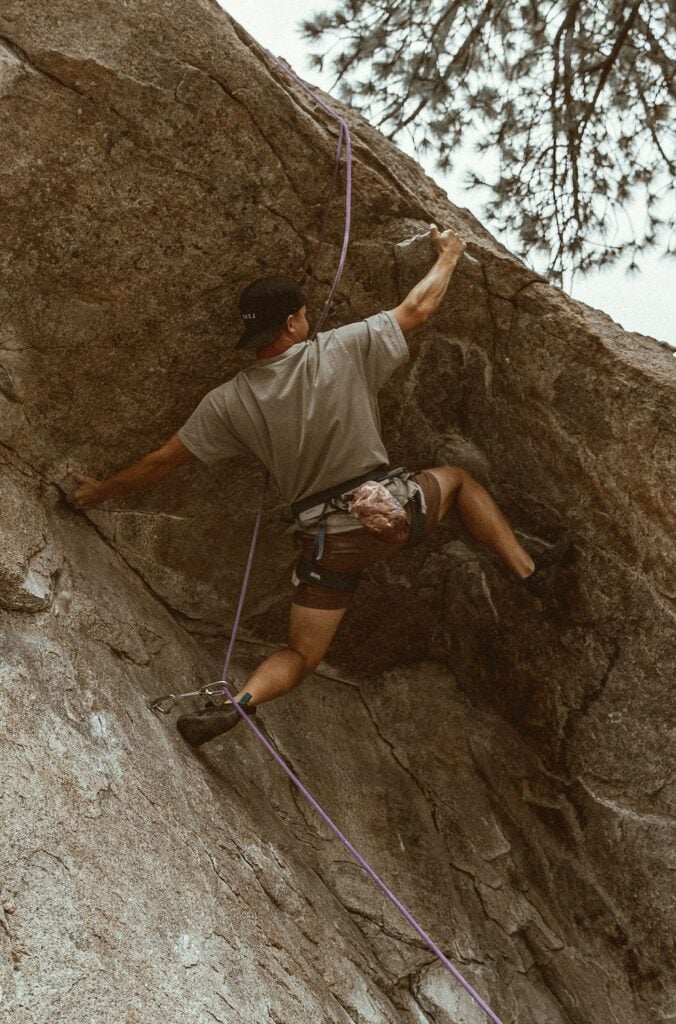
37. Dynamic
The main characteristic of a climbing rope. The dynamic ropes used for climbing stretch to reduce the impact force on the climber in case of a fall. By opposition, static ropes do not stretch and are only used for hauling gear and rappelling.
The adjective dynamic is also used to describe a type of climbing movement. With dynamic climbing, the climber leaps from one hold using momentum to move more efficiently. Dynamic climbing is common on a boulder problem but can also be found in other forms of free climbing, especially in crux sections.
38. Dyno
Short for ‘dynamic’ in climbing, a dyno is a powerful movement, often a jump, that uses momentum to reach the next hold.
39. Edging
A technique in which the climber uses the edges of their shoes to stand on small footholds.
40. Face
With face climbing, climbers use friction and rely on rock prominences like edges, jugs, and finger pockets to ascend. In contrast, crack climbing requires jamming hands and feet in fissures to create body leverage and opposing forces.
41. Figure 8
A climbing knot in the shape of the number eight that a climber uses (in its double version) to tie the rope to their harness. A figure 8 knot can also be used in its single version to prevent a rope from running out (through a belay or rappel device, for example).
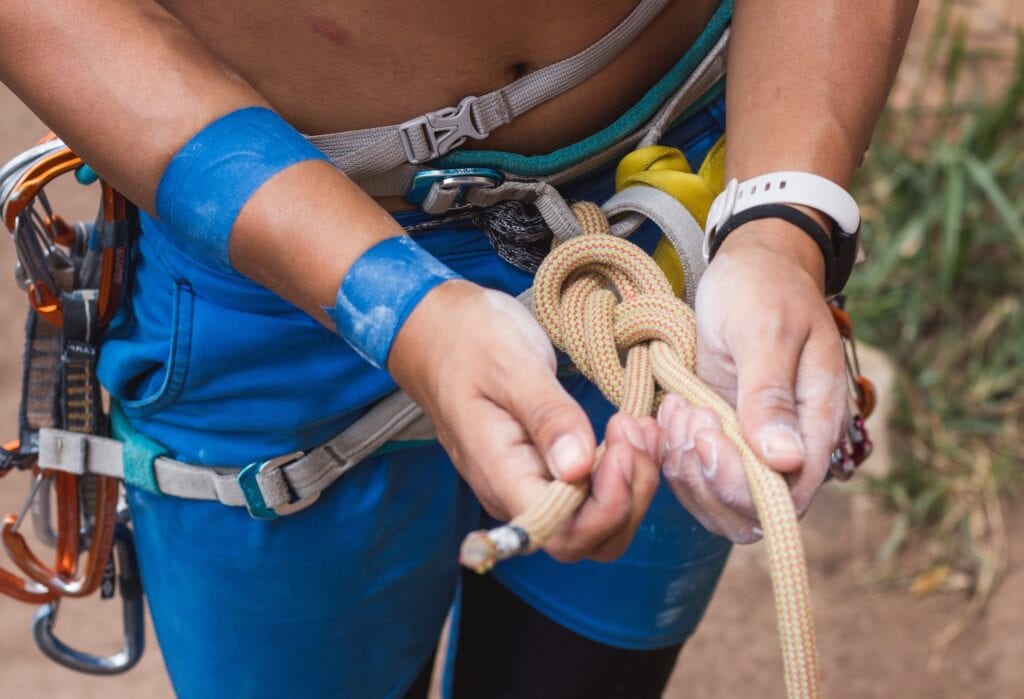
42. Fisherman’s knot
A powerful knot that climbers use to tie the ends of two cords together like ropes or cordelettes.
43. Flagging
Flagging is an important body positioning climbing technique in which the climber uses one free leg as a counterbalance to keep their center of gravity close to the wall and under control.
44. Flash
A successful lead climbing ascent on the first try (i.e., without falling or pulling on the protection gear), utilizing existing information (e.g., beta) from other climbers or guidebooks. See also: on-sight.
45. Follow
To climb second on a pitch that the leader has just completed. Following mainly applies to multi-pitch climbing. In traditional climbing, the follower’s role is to clean the protection the lead climber has placed in the rock.
46. Free Climbing
Any type of climbing in which the climber ascends solely using their power and the rock’s natural features. Using gear (e.g., ropes, quickdraws) is allowed, but only for protection. Free climbing is the opposite of aid climbing.
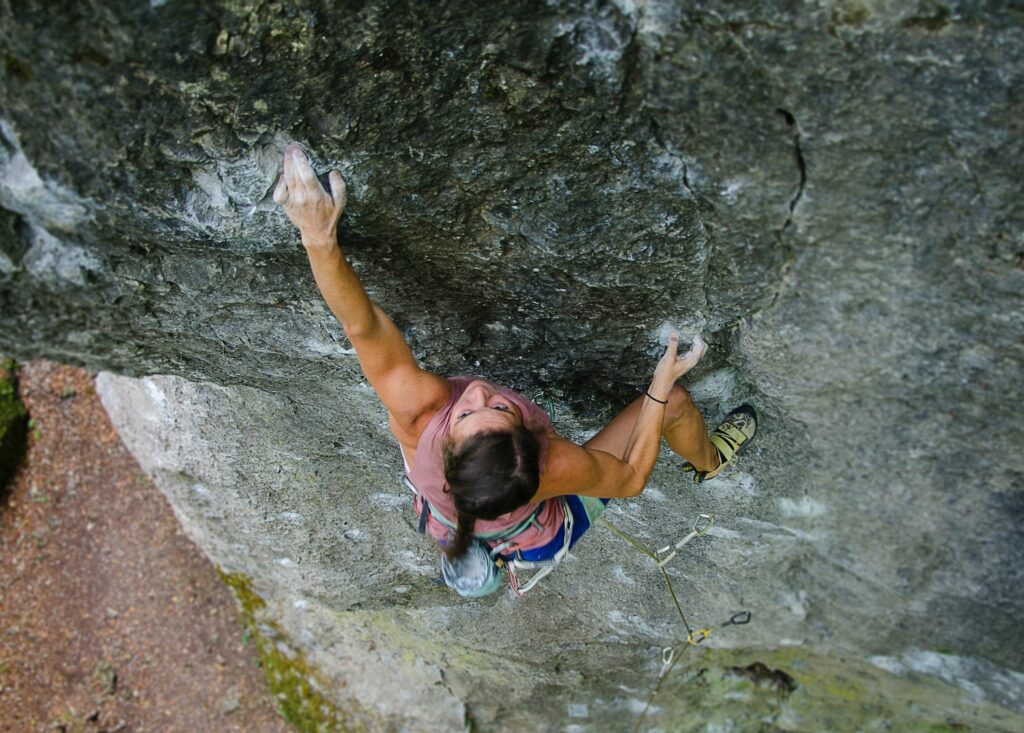
47. Free Solo
Free soloing (or free solo climbing) is a rare and highly-dangerous type of free climbing that sees the climber ascending a route at a height where a fall is likely to result in death or serious injury without a belay for safety.
48. Friend
The first spring-loaded camming device used for protection invented by Ray Jardine and commercialized by British climbing company Wild Country.
49. Gate
The spring-loaded opening of a carabiner. A gate can have a straight or bent shape and be equipped with a lock (e.g., twist lock or screw lock), depending on the usage.
50. Grigri
The Grigri is the first and most popular assisted-braking belay device. Made by Petzl, its name refers to a word of African origin used in the French language to designate a talisman for good luck.
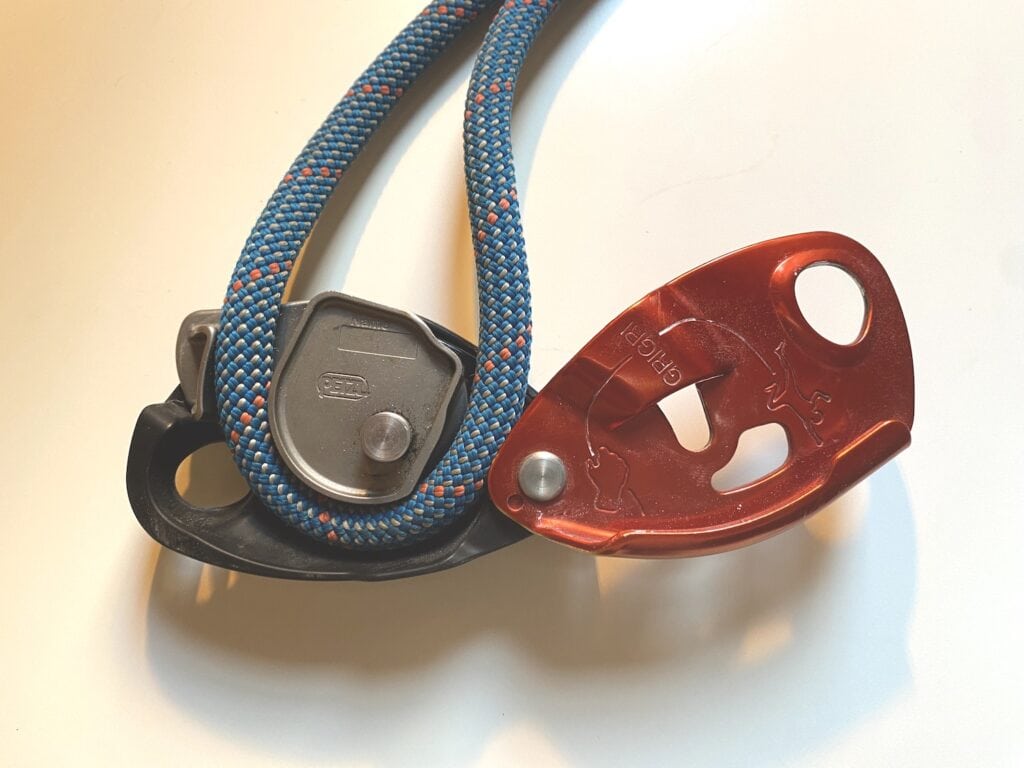
51. Climbing Gym
An indoor climbing facility with artificial walls. Most climbing gyms offer roped-climbing routes, bouldering problems, or a combination.
52. Half Rope
Also known as a double rope, a half rope is a thinner rope (less than 9 mm) used as a pair, allowing the climber to clip each rope independently. Half ropes are primarily used for multi-pitch climbs. See also: twin rope.
53. Hang dog
Hangdogging refers to hanging on the rope to rest while climbing a route. To hang dog disqualifies the climber from a free ascent. However, it’s a common practice to work on a rock climb in preparation for a redpoint ascent.
54. Harness
A piece of strong webbing safety equipment with a belt, leg loops, tie-in loops, and a belay loop where the climber secures a rope or anchor. The seat harness is the most common among climbers, but there are also full-body harnesses for children and pregnant persons.
55. Heel hook
One of the most common climbing footwork techniques for the intermediate and advanced levels. The climber places their foot on a hold or ledge and applies pressure with the heel to get closer to the wall and generate power for their next move. Check out our guide for more information.

56. Jam
Placing a body part into a crack in the rock to gain leverage or stability in order to ascend a climbing route. Crack climbing typically requires climbers to wedge their hands and feet into cracks, sometimes even arms and legs.
57. Jug
A jug is any large handhold, natural or artificial, with an open shape, making it easy to grip with one or two hands.
58. Jumar
The name of the first mechanical ascender invented by Adolf Jüsy and Walter Marti in 1958. It quickly became a generic term for any ascender and even a verb: to jumar/jumaring.
59. Kilonewton (kN)
An expression of the newton, the standard international unit of force, with one kilonewton (1 kN) being equal to 100 kg/220 lb of load under Earth gravity. Climbing gear uses kN as a rating to indicate how much force it can sustain in the event of a climber’s fall. For example, a carabiner rated 23 kN can hold 2,300 kg/5,071 lbs of force.
60. Last
The last is a 3-dimensional mechanical form that defines the shape of the shoe. Also called the “heart of the shoe,” the last replicates the shape of a human foot.
61. Lead Climbing
A method of climbing in which the climber brings the rope with them from the ground and clips it to permanent anchors or removable pieces of protection as they ascend. More info here.

62. Lower
The action of bringing a climber down from the top or a mid-section of a climbing route by continuously and slowly giving rope through the belay device until the climber reaches the ground. Lowering mostly applies to single-pitch climbing.
63. Mantel
Mantling is a unique technique in climbing in which the climber brings their center of gravity past a horizontal ledge by pressing down with the hands, locking off, and placing the feet high. The mantel is especially common in bouldering, where climbers top out, meaning they go over and stand on the boulder.
64. Multi-pitch
Multi-pitch climbing describes the ascent of a large rock wall or mountain with at least one stop at a belay station on the way to the top of the climb.
65. Nut
A piece of passive protection used in trad climbing that combines a metal wedge attached to a wire.
66. On-sight
To free climb a route on the first attempt without prior knowledge or inspection of the different sections and their moves.
67. Passive protection
Any protection piece used in trad climbing that doesn’t have moving parts (e.g., nuts and stoppers). In opposition to active pro, passive pro doesn’t expand or contract in the rock; it only stays in cracks and holes because of its shape.

68. Pitch
The length of a climb (or section of a climb) that can be climbed with a typical rope for protection (i.e., 50-80 meters/160-260 feet). However, a pitch can be shorter than one rope length to minimize rope drag or benefit from a natural belay station. For example, the Dawn Wall route free climbed by Tommy Caldwell and Kevin Jorgeson has 32 pitches for a total length of 900 m/3000 ft, giving an average pitch length of 29 m/94 ft.
69. Piton
A spike-shaped metal piece of climbing equipment that aid climbers drive into the rock face to secure the climbing rope for protection. Pitons damage the rock and, therefore, are seldom used nowadays in favor of modern gear like nuts and cams.
70. Placement
A natural feature in the rock that can accommodate a piece of protection to secure climber falls.
71. Pocket
A small hole in the rock where the climber can fit one or two fingers at most.
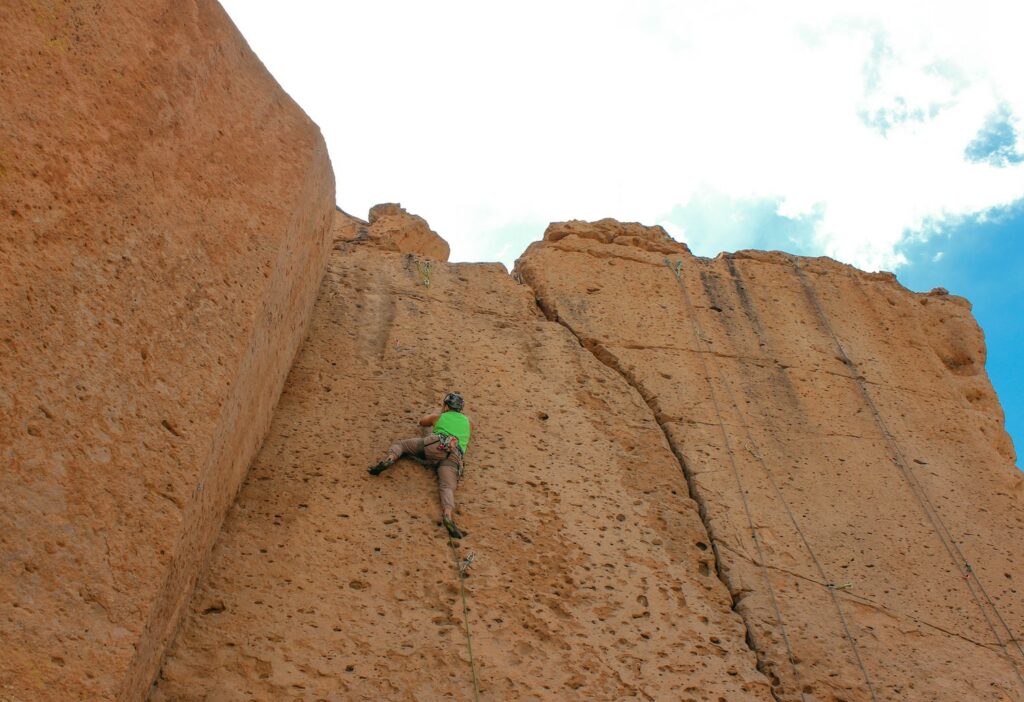
72. Protection
Any equipment used by climbers to protect themselves in the event of a fall. Climbing protection ranges from crash pads in bouldering to camming devices in trad climbing and everything in between.
73. Prusik
The Prusik is a sliding friction knot or hitch invented by mountaineer Karl Prusik where the climber wraps a loop cord around a rope. The climber moves the loop by sliding it. However, the knot will block with friction if force is applied.
74. Pumped
A physical condition characterized by weakened forearms from a route (or section of a route), making it difficult to climb further. Pumped arms can recover with a few minutes of rest (hang dogging, for example), but sometimes it can force the climber to end the session and call it a day.
75. Quickdraw
Two non-locking carabiners connected by a dog bone (a thick and rigid sling) with a rubber fastener to keep the lower carabiner from moving. Quickdraws are used in sport climbing to secure the rope to the pre-bolted anchors on the rock or artificial wall.

76. Quicklink
An oval ring that is closed with a screw gate. Quick links differ from carabiners in that they don’t have a spring-loaded gate. They are especially useful for building anchors.
77. Rack
The collection of gear brought by a climber for a climb or climbing zone. In trad climbing, the term “racking” refers to selecting all the right pieces of protection to secure a specific route (often multi-pitch).
78. Rand
The rubber zone that wraps around a climbing shoe where the sole connects to the upper.
79. Rappel
A technique of lowering oneself down a rope secured to a top anchor using a rappel device, often to descend after a climb.

80. Ratings
The grades using numbers (and sometimes letters and symbols, e.g., 6a+) that climbers assign to routes to evaluate their respective difficulty. Climbing grades are consensus-based and belong to a system (e.g., Yosemite Decimal System, French, V-Scale, Fontainebleau).
81. Red point
To successfully free climb a route in one or more tries. If completed in just one attempt, a red point is also called a “flash” or even “on-sight” if the climber had zero prior knowledge of the climb.
82. Retiring gear
To stop using critical gear for climbing (e.g., rope, harness, sling) because of safety concerns due to apparent damage, a significant event like a whipper, or age.
83. Runout
An unprotected section of a climb. The runout length is equal to the distance between the climber and the last protection piece. On sport routes, runout is determined by how far apart the pre-drilled bolts have been installed. In trad, the climber can, to some extent, manage the runout by placing more protections if they are able to find suitable placements.
84. Screamer
A fall so long that the climber has time to scream, hence the name.

85. Second
To climb in second position (after the leader) in the context of multi-pitch or alpine climbing.
86. Sewing-machine leg
Also known as disco leg, sewing-machine leg is a physical phenomenon caused by fear or exertion characterized by muscle spasms causing the legs of the climber to shake uncontrollably.
87. Sheath
The outer part of a climbing rope encasing its core.
88. Single rope
As the name indicates, a single rope is used by the climber on its own: they secure it to each protection piece. As such, it needs to be strong enough to support a leader fall. Most single ropes have a diameter between 8.9 and 10.5 mm.
89. Slip-lasted
A sock-like footwear construction prevalent for bouldering and sport shoes that delivers high sensitivity at the expense of support. The alternative is board lasted shoes.
90. Smear
When smearing, the climber uses the friction of rubber sole against the wall as a foothold to ascend.
91. Speed climbing
A climbing discipline where the climber’s goal is to ascend a route, indoor or outdoor, as fast as possible. Competition speed climbing is practiced on a 49-ft (15 m) artificial wall with a 5-degree angle of overhang and an approximate difficulty of 5.10c (6a+). The layout of the holds is identical across the competitions worldwide and hasn’t changed since the discipline started. The speed climbing world record is 4.90 seconds and was set by Veddriq Leonardo (Indonesia) on April 28, 2023.

Speed climbing was one of the three modalities at the 2020 Tokyo Olympics‘ climbing event with lead climbing and bouldering. However, it will be a standalone competition at the 2024 Paris Olympics.
92. Sport climbing
A style of free climbing on rock or artificial plastic walls equipped with permanent protection like pre-drilled bolts or a top-rope anchor. Sport climbing is an evolution of traditional climbing, another form of free climbing that relies on removable protection.
93. Static
Static climbing refers to a type of movement where the climber moves without any jumps and lunges, relying instead on reach, careful body positioning and precise footwork.
The adjective static is also used to describe a rope that doesn’t stretch, and thus is only suitable for hauling gear and rappelling.
94. Stick clip
A device that allows climbers to clip a quickdraw to a distant bolt. The clip can be mounted on a telescopic stick or a simple pole. Although some so-called purist climbers snear at the stick clip, calling it a “cheat stick”, the clip stick is an incredible device to make routes with a high first clip safer for lead climbers.
95. Toe hook
A climbing technique that consists of using the toes and the top of the shoe’s forefoot as point of contact with the wall to stabilize the body and progress upwards. Toe hooking is especially important on overhanging terrain to keep the body close to the wall.

96. Top out
To complete a boulder problem by standing on top of the boulder. Often, toping out involves mantling if there are no further holds for the climber rely on. Mostly outdoor problems have top outs. However, some indoor gyms install platforms at the end of the route for boulderers to practice topping out.
97. Top rope
A rope secured to a fixed anchor at the end of a climbing route with one end tied to the climber’s belay loop and the other passed through the belayer’s belay device. Top rope climbing is the practice of ascending with a top rope for protection. As the rope is always secured above the climber (unlike in lead climbing where the last protection is often below the climber), top roping one of the safest climbing disciplines.
98. Traditional climbing (“trad”)
A type of free climbing where the lead climber places temporary protection (e.g. nuts, camming devices) to secure the rope as they ascend, later removed by the follower. Trad climbing‘s ethics aim to leave the rock untouched as opposed to sport climbing where routes are equipped with permanent bolts.

99. Twin rope
A type of climbing rope designed to be used in pairs with both strands clipped to each piece of protection on the climbing route. Twin ropes are thinner in diameter than single ropes, i.e. 7-8 mm.
100. Whipper
A long fall in lead climbing due to a combination of factors like runout, the stretch of the dynamic rope, excessive slack from the belayer, or failed placement (in trad).

